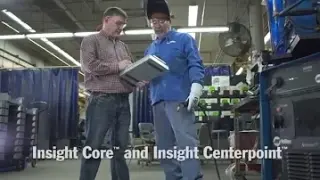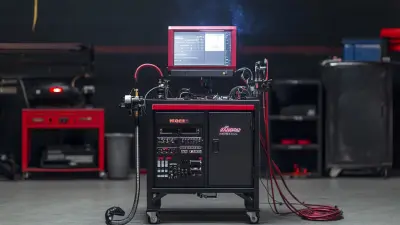Ever since the advent of modern manufacturing, innovation has been considered the spearhead to create more efficient manufacturing processes, improved product quality, and lesser costs. Amongst these innovations, the recently developed multipurpose equipment known as the Flux Welder has begun to dominate the scene. This multifunctional equipment will change the conventional welding process in favor of accommodating the stringent requirements of contemporary manufacturing environments. The capability of the Flux Welder to produce very high-quality welds in various materials makes it a flexible tool to industries ranging from automotive to aerospace.
At Taizhou Yike Electromechanical Co., Ltd., we fully realize that one must remain current with technology. Thus, by utilizing cutting-edge equipment such as Flux Welders, we have secured a leadership role in the industry. Implementing these innovative machines into our manufacturing processes enhances our operational capabilities while also serving the varying needs of our clients accurately and reliably. This blog will investigate the novel applications of Flux Welders and how they are changing the future of manufacturing.

Innovative welding techniques in the aerospace industry are enhancing manufacturing processes. Flux welders are among these advancements, impacting systems that allow for precision and efficiency with precision and efficiency. These welders allow for the joining of dissimilar metals, which is paramount in the aerospace industry, where weight and strength of materials matter. Another improvement in this area is the introduction of specialized flux systems that optimize the brazing process. These advancements enhance joint quality and decrease assembly time and costs, thus making the production process more streamlined. As aerospace manufacturers explore different materials and designs, flux welders will become indispensable in guaranteeing structural integrity and performance to satisfy the stringent demands of the industry.
Welding with flux technology has also contributed to modern manufacturing in providing greater efficiency and versatility in fabrication. Based on arc welding, flux welding is characterized by a protective layer of flux, which is put over the molten weld to protect it from possible contamination while at the same time aiding the quality of the weld. Hence, this reason adds more value in itself in industries, which are facing the increasing demands of durability and accuracy.
The recent developments in hardfacing welding are just one side of the growing innovation in this field. The hardfacing welding market is growing, and this further suggests the rising awareness of wear-resistant materials in manufacturing. New deposition techniques including oscillation and weaving are explored to optimize hard structures for their longevity and robustness in industrial applications. These advanced welding technologies are going to define the future production technologies for resilient manufacturing as manufacturing processes advance.
Flux welding is a significant modern manufacturing technique. It has varied advantages that promote the economics of production. One is the provision of strong and durable welds during hard-facing applications. Since hard-facing welding market trends forecast higher growth rates in the next few years, therefore, manufacturers are fast adopting flux-welding technologies for improving wear resistance and elongation of life span of equipment.
In addition, flux welding is much speedier than other welding methods. This gives companies some blanket include of reducing lead time in meeting the increasing demands. For instance, companies that switched to flux-based techniques from TIG welding on chrome alloys are noting improved efficiency, lowering lead and delivery time. It further gives a very much increased safety margin; the new welding machines have better safety with ergonomic considerations for operators. The welding market will see continuous growth, and the innovative burden of flux welders will cause dramatic changes in manufacturing processes.
Innovative principles flux welding techniques become ever more vital with regard to sustainability in today's manufacturing processes. They have proven that energy-efficient techniques, such as the Fbca welding on the flow bands and constricting arc, can reduce energy consumption and material waste in the industry. This will not only optimize the fabrication of complex structural forms but also reduce environmental load intending towards innovative manufacturing with increasing importance on sustainability.
Meanwhile, the welding wires market is also growing rapidly, which reflects the increasing usage of the manufacturing consumables with higher efficiency and eco-friendliness, where all manufacturing organizations are now quickly adapting green technology into their production lines. Advanced methods of welding would be the enthusiasm to fulfill operational efficiencies and environmental standards for the high-tech industries of the future. Indeed, these bring promising tadventures toward a better tomorrow in the industry.
Most of the welding techniques using flux have been widely accepted in automotive manufacturing because of versatility and efficiency. Flux-cored wire can provide excellent welding with a good shield against atmospheric impurities. This is particularly vital in automotive applications, where structural integrity and durability are of utmost importance.
Odyssey welding equipment has developed very recently with modern flux welding machines that can perform intricate jobs such as never before. All-in-one multiprocess capabilities allow welding to shift effectively from one type to the other, increasing production workflow efficiency. As newer welding technologies gain acceptance in the automotive industry, this can create a high demand for skilled technicians trained in the latest flux welding techniques, ushering in a new manufacturing excellence paradigm.
Recently, the trend in manufacturing has tilted towards automation, and the fuse-welder used in integrating and significantly utilizing these welders is closer to such advancements. The use of modern features on flux welders these days that increase their technical efficiencies and the level of precision that they also improve weld quality standards. Automation will allow for real-time monitoring and adjustments such that the welding processes can be made consistent and error-free, especially in high-volume production lines.
Moreover, with manufacturing facilities moving towards not-so-conventional forms, so has been emphasized further the role of flux welders in joining dissimilar materials. This automated system's compatibility with the new-age welding wire expands applications, covering ground from the automobile sector to that of aerospace. This marks a revolutionary leap between automation and flux welding, where manufacturers will fabricate their operations with much more reliability and productivity while preparing a ground for future innovations in welding technology.
Flux welder evolution shares a historic journey with the development of manufacturing technology. The initial purpose for flux welding was to improve metal joining, but much development on flux welding was accomplished since that time. It was used for applications where ordinarily, other methods might fail but flux welding was able to give off strong, tough welds under observation in different environmental conditions.
In the recent past, flux welder applications have matured, especially in aviation and automotive areas. These sectors rely on the competent assembly of complex aluminum structures using flux welding. Innovations such as flux band technology have surfaced, proving to enhance operational efficiency and energy savings. As developments in manufacturing continue to unfold, the history cemented in earlier advancements on flux welding is still seminal to contemporary improvements.
Flux welding is a key technology in the modern manufacturing context, with many innovative applications that advance efficiency and precision. Recent case studies conducted in factories have demonstrated that the introduction of advanced welding consumables, including flux-cored wires, has greatly enhanced the joining of dissimilar metals and plastics. The new technologies in welding not only simplify the production processes but also provide solutions for complex materials, which are the ones often essentially used in advanced manufacturing.
Thus, the factories applying the latest welding-methods use these new applications to improve the durability of their welded joints and reduce waste into sustainable activity. In particular, the applications of advanced manufacturing welding processes have enabled the optimization of operations, which, in turn, are expected to increase the welding consumables market growth. By exploiting these new applications, the manufacturers can be able to meet the demands of a competitive market while still following through with quality and sustainability parameters.
Flux welding is challenged and limited in various aspects when applied in modern manufacturing processes. One great trouble is fume control during welding, which has become prominent in recent days. Manufacturers have been keen on ensuring acceptable indoor air quality, particularly after the COVID-19 pandemic. Health hazards have arisen from uncontrolled emissions of traditional flux welding, creating a need for innovative solutions to reduce fume exposure with little or no impact on productivity.
Another challenge is that the more advanced processes are taking over from traditional processes. Although traditional flux welding works quite well, new techniques like flux bands constricting arc (FBCA) welding are coming up to make the work easier when dealing with complex structures like metal sandwich panels. With the emergence of these new techniques, manufacturers are left grappling with changing circumstances and the inherent shortcomings of flux welding, which mostly focus on internal control of flow behavior during welding.
Advancement opportunities for flux welding technology have risen significantly, especially in the development of energy-efficient measures such as flux bands constricting arc (FBCA) welding. The application of this new technique enables metal sandwich panel fabrication while addressing indoor air quality. Lessons learned from the COVID-19 pandemic have encouraged and inspired manufacturers to prioritize weld fume controlling in a safer work environment for every worker on the shop-floor.
Projected robust growth of the welding wires market shows that there is an increasing trend toward using more advanced materials in welding processes. This market is expected to cross the figure of USD 21 billion by 2032; a pointer to the general trend towards the more innovative welding technologies and hence optimized manufacturing processes. As new methodologies and materials are discovered by manufacturers, modern welding will finally show how these innovations would become part of future operations concerning performance and sustainability.
Flux welding technology is a modern welding process built on arc welding principles, utilizing a protective layer of flux that shields the molten weld from contamination and enhances weld quality. This contrasts with traditional methods, which may not provide the same level of protection and quality assurance.
Flux welding offers several advantages, including producing strong and durable welds, particularly suitable for hardfacing applications, faster welding processes, reduced lead times, and improved ergonomic safety for operators.
By improving wear resistance through strong, durable welds, flux welding techniques help extend the lifespan of manufacturing equipment, making it more resilient to wear and tear.
Hardfacing welding involves applying wear-resistant materials to surfaces to enhance durability. Its significance lies in the growing recognition of the need for robust materials in manufacturing processes, which flux welding effectively addresses.
Recent advancements include exploring oscillation and weaving deposition strategies to optimize the formation of hard structures, ensuring improved longevity and robustness in products.
The welding market has expanded due to the innovative applications of flux welding technologies, leading to increased recognition of their benefits, such as enhanced efficiency and safety in manufacturing.
Flux welding boosts production efficiency by allowing for faster welding processes, enabling manufacturers to meet increasing demands more effectively compared to traditional methods.
Yes, advancements in welding equipment used in flux welding have improved ergonomic safety for operators, making the overall process safer.
Flux welding is particularly beneficial in applications that require hardfacing, as it provides the necessary durability and wear resistance for high-stress environments.
The flux not only protects the molten weld from contamination but also actively contributes to the overall quality of the weld, ensuring better adhesion and integrity of the joined materials.





